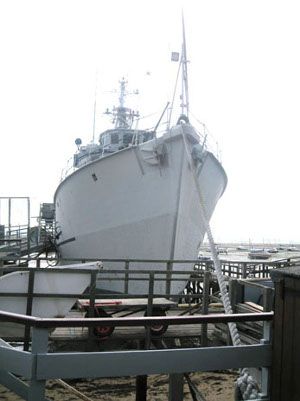18.02.2015
Port of London Authority's sewage-ban-byelaw comes into force
- Byelaw 49 bans certain vessels, including houseboats, from discharging sewage into the Thames
- Port of London Authority’s environment team works hard to guide and advise river users on byelaw
- Yacht club installs sewage pipe to deliver floating club house’s waste water to main system.
A drive to make the tidal Thames cleaner for current and future generations is already helping river users change how they deal with sewage waste.
Byelaw 49, created by Port of London Authority (PLA) to stop waste water being dumped in the Thames, came into force at the beginning of the year. Designed to stop certain vessel owners, including those in houseboats, from discharging sewage, the measure is designed to protect the river’s environment – making it cleaner and healthier for many years to come.
The PLA’s environment team have been working hard to ensure river users know why the byelaw was brought in and what it entails. Using various channels, including public meetings, open days, the PLA website and even an audit to check how many people would be affected, our staff have been carefully explaining to affected people the options they have to comply with the byelaw.
Our Environment Manager Tanya Ferry said: “Our new byelaw is already having a transformative and positive effect on what river users do with their sewage. A fine example is being set by Essex Yacht Club. Its members and staff have been working tirelessly to overhaul their system and the results should be commended.
“We have worked closely with them and other parties to make sure the ins and outs of Byelaw 49 are understood. And while changing what you do with your sewage can be a time-consuming business; we’re sure that river users will recognise the benefits of doing so.”
Byelaw 49 is enforced through PLA’s river works licensing team. All floating clubhouses and houseboats along the river will need to consider what facilities they provide, in order to comply. The byelaw also serves as a forerunner to the Thames Tideway Tunnel, a project to tackle the problem of overflows from London’s ageing sewers. "It will see a 16-mile overflow tunnel erected under the Thames and work on the project begins in 2016."
Yacht club flushed with success
 Essex Yacht Club (EYC) in Leigh-on-Sea, whose historic floating clubhouse, Wilton, (pictured left) had been discharging sewage since it became the club’s HQ 11 years ago. The refurbished, former mine hunter, which was the first ever Glass Reinforced Plastic warship, has been the club’s HQ since 2004. And as it’s the venue for countless club social events, meetings and fundraisers, its sewage system had to be transformed if it was to carry on being EYC’s focal point.
Essex Yacht Club (EYC) in Leigh-on-Sea, whose historic floating clubhouse, Wilton, (pictured left) had been discharging sewage since it became the club’s HQ 11 years ago. The refurbished, former mine hunter, which was the first ever Glass Reinforced Plastic warship, has been the club’s HQ since 2004. And as it’s the venue for countless club social events, meetings and fundraisers, its sewage system had to be transformed if it was to carry on being EYC’s focal point.
Following advice, consultation and encouragement from the PLA, as well as weeks of work by contractors and club members, the club last month revealed that a project to take Wilton’s waste water to the main sewerage system had been a success. A 550-metre-long pipe now transports the sewage, meaning less pollution in the Thames.
The project cost around £100,000 and was financed, in part, by a Sport England grant.
Patrick Grant, EYC’s Rear Commodore, thanked the PLA for its support, advice and understanding. He said:
“It’s finally finished and it meets the requirements of the new byelaw. We’re so pleased with what was a very difficult project to complete. It’s something we’ve been keen to do for a long time and club members are so glad it’s been completed. The good news is that it works.”
In November, Yacht Club Commodore Alec Pell-Johnson said:
“We’ve been planning to carry out this work for years as we are anxious to be as environmentally friendly as possible and have been liaising closely with all the relevant agencies, including Network Rail, the Council, the Environment Agency and Natural England.
About Byelaw 49 and the Port of London Authority
The Byelaw prevents the discharge of sewage into the Thames from specified vessels, consistent with the continuing improvement of the Thames environment, particularly with Thames Water’s project to minimise the discharge of untreated sewage into the river, and brings the Thames into line with a number of other UK harbours and inland waterways.
For the purposes of this byelaw, sewage refers to faeces and urine plus any water associated with them.
For more information, please visit: https://www.pla.co.uk/Environment/Byelaw-49-Prohibition-of-discharge-of-sewage-to-the-Thames
The PLA’s operations cover 95 miles of the River Thames. We work to keep commercial and leisure users safe, protect and enhance the environment while promoting the use of the river for trade and travel.

